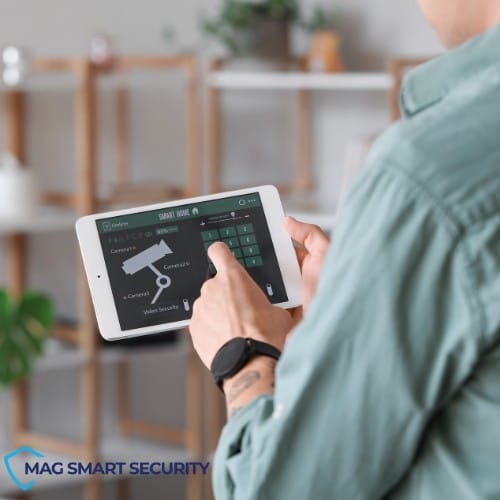Folllow Us:

Home monitoring systems are like 24/7 guards for your house, maximizing your existing smart tech to keep your family safe and sound. The control panel is the boss, communicating with every part of the system to ensure things run smoothly. Sensors look out for potential trouble, like smoke or unexpected guests.
In this article, we’ll get into how all these pieces work together to keep your home secure, from the different kinds of sensors to how they help prevent real-world risks.
These systems have continually adapted to meet the changing security challenges and needs of society. We’ll trace its journey, highlighting key developments and technological milestones that have redefined home security.
Before modern technology, home security meant moats, drawbridges, and guard animals. A similar source explains that in 1853, Augustus Pope introduced the first burglar alarm using electromagnets. Consumer interest in home security surged post-World War I, leading to unique solutions like “door shakers“- a group of watchmen – ensuring doors were locked at night.
The concept of video surveillance emerged in the 1940s, but it wasn’t until Marie Van Brittain Brown patented a video home security system in 1969 that it became a household feature. By the 1980s, as costs dropped, these systems became household staples, with security firms offering lower installation fees for recurring monitoring charges.
Until the 1990s, security systems were predominantly hardwired, presenting challenges in installation, upgrading, and vulnerability, as criminals could disable them by cutting phone lines.
Studies confirm that the advent of WiFi in 1997 was a game-changer, enabling wireless video transmission and resolving hardwiring issues. The 2000s saw an uptick in remote home monitoring services, and the market shifted towards do-it-yourself security setups. This empowered homeowners to install and manage their systems.
Introducing Bluetooth-enabled wireless sensors led to a new wave of smart home security devices, controllable via smartphones. Current DIY systems have revitalized decades-old technology, like motion and contact sensors, by enhancing their design and functionality. The reliance on internet-connected cameras has raised privacy concerns due to hacking incidents.
Origin Wireless’s Hex Home security system exemplifies innovation, using WiFi Sensing technology to detect movement without traditional cameras or sensors, providing extensive coverage and high accuracy, including pet-friendly settings.
This system represents a new era in home security, moving beyond conventional methods and paving the way for future advancements prioritizing the protection of homes and families.
Below is an overview of the core components that form the backbone of an effective home monitoring system:
The control panel is the main controller for your home security system. It’s where all your alarms and sensors connect and communicate. It uses Wi-Fi, cellular signals, or a wired connection to send messages and connect to other smart home devices.
The following is a table summarizing its functions and connectivity options:
Function | Connectivity Option |
Alarm Activation/Deactivation | Wi-Fi |
Sensor Integration | Cellular Network |
Emergency Notification | Ethernet (Wired Internet) |
System Diagnostics | Z-Wave/Zigbee (Home Automation Protocols) |
Real-Time Monitoring | Bluetooth |
Sensors are the alert system for your home, each designed for a specific job:
Sensor Type | Placement | Role in Intrusion Detection |
Door/Window Sensors | On or near doors and windows | Alert when a door or window is opened |
Glass Break Detectors | Near glass windows or doors | Detect the sound frequency of breaking glass |
Smoke Detectors | On ceilings or high on walls | Sense smoke to raise an alarm for potential fires |
Motion Detectors | In large open spaces or hallways | Detect movement within a specified area |
CO Detectors | Near bedrooms and living areas | Detect carbon monoxide presence and prevent poisoning risks |
Door and window sensors have magnets that signal when they move apart from opening a door or window. Glass break detectors have special mics that listen to the sound of glass breaking. Smoke detectors see smoke in the air using a light or a tiny bit of radiation.
Indoor cameras assist you in monitoring activities within your home. You can use them to keep an eye on your kids and pets or ensure everything is secure when you’re away. People commonly place them in areas such as living rooms or kitchens.
Feature | Benefit |
Night Vision | Allows the camera to see in complete darkness. Ensures 24/7 monitoring. |
Motion Tracking | The camera can detect and follow movement. Records any activity in its field of view. |
Live Streaming | Provides real-time video feed accessible from anywhere through a smartphone or computer. |
Outdoor cameras are tough and built to handle weather like rain or snow. They’re great for watching over the outside of your house, like your yard or front door.
Feature | Benefit |
Weatherproof | Resistant to extreme weather conditions. Ensure functionality no matter the weather. |
Placement | Positioned to monitor entry points and outdoor areas for any suspicious activity. |
These outdoor cameras can work with lights and motion sensors, too. Furthermore, if they detect movement, they can turn on a light, which helps scare off intruders and lets the camera see better.
Alarms are essential to a home security system, designed to alert you and others of a potential threat. There are two main types of alarms: audible and silent.
Below is a table that outlines their purposes:
Alarm Type | Audible Alarms | Silent Alarms |
Purpose | To scare off intruders with a loud noise and alert occupants and neighbours. | To discreetly notify authorities without tipping off the intruder. |
Motion detectors play a role in home security and automation. They sense movement and can trigger responses like turning on lights or sending a security alert.
Detector Type | Infrared (PIR) | Microwave |
How it Works | Detects changes in heat (like a person moving) | Emits microwaves and measures changes in the pattern |
Placement | Usually installed on walls or corners | Can be placed almost anywhere, less common in homes |
Range | Typically limited to the room they’re in | Can cover a larger area and go through walls |
Cost | Generally less expensive | Usually more expensive |
False Alarms | Less likely to be triggered by small animals | More sensitive, can be triggered by any movement |
Pet-Immune Motion Detectors:
These devices are specifically designed to minimize false alarms by disregarding the movement of pets. They achieve this by identifying heat and size patterns that do not correspond to human characteristics. Your pets can freely roam without triggering the alarm system.
Component | Function | Tech Advancements | Pros and Cons |
Control Panel | Coordinates all security components. | Smart integration, wireless connectivity. | Pros: Central control, real-time alerts. Cons: Complexity, single failure point. |
Sensors | Detect entry and environmental hazards. | Enhanced sensitivity, smart differentiation. | Pros: Accurate detection, easy install. Cons: False alarms if not well set up. |
Indoor Cameras | Monitor inside activities. | Better image quality, and motion detection. | Pros: Real-time monitoring. Cons: Privacy concerns, blind spots. |
Outdoor Cameras | Watch exterior spaces. | Weatherproof, high-res in low light. | Pros: Deterrence, perimeter watch. Cons: Higher cost, maintenance needs. |
Alarms | Alert to breaches. | Smart emergency differentiation. | Pros: Loud deterrence, emergency alerts. Cons: Noise pollution, false alarms. |
Motion Detectors | Detect movement, trigger responses. | Pet immunity, smart home integration. | Pros: Improves camera/alarm efficiency. Cons: Limited range. |
Security cameras are widely recognized as a deterrent to crime, but they need to be foolproof. Research from leading criminology institutes indicates that while they can’t stop all crime, they generally help to reduce it. Now, let’s look at what the data says.

101 – 7261 River Place, Mission, BC
V4S 0A2
